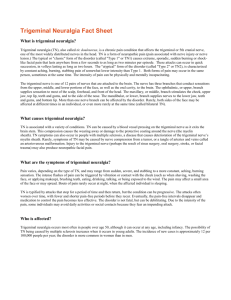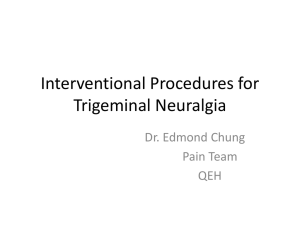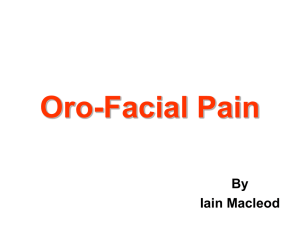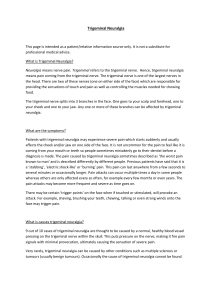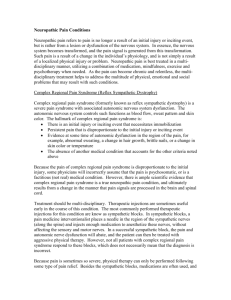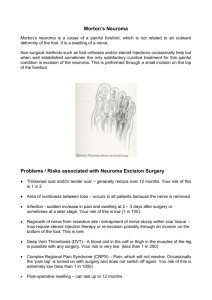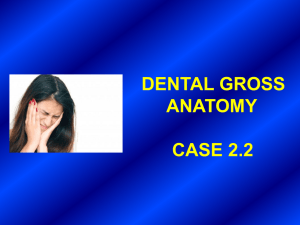Trigeminal Neuralgia
advertisement
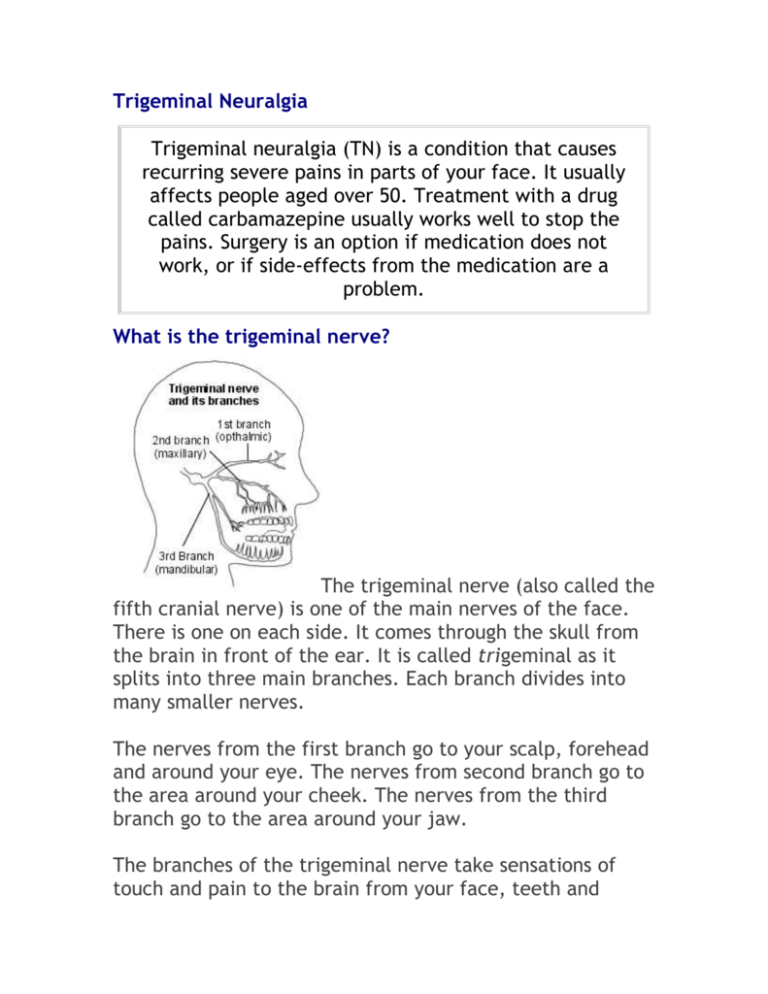
Trigeminal Neuralgia Trigeminal neuralgia (TN) is a condition that causes recurring severe pains in parts of your face. It usually affects people aged over 50. Treatment with a drug called carbamazepine usually works well to stop the pains. Surgery is an option if medication does not work, or if side-effects from the medication are a problem. What is the trigeminal nerve? The trigeminal nerve (also called the fifth cranial nerve) is one of the main nerves of the face. There is one on each side. It comes through the skull from the brain in front of the ear. It is called trigeminal as it splits into three main branches. Each branch divides into many smaller nerves. The nerves from the first branch go to your scalp, forehead and around your eye. The nerves from second branch go to the area around your cheek. The nerves from the third branch go to the area around your jaw. The branches of the trigeminal nerve take sensations of touch and pain to the brain from your face, teeth and mouth. The trigeminal nerve also controls the muscles used in chewing, and the production of saliva and tears. What is trigeminal neuralgia (TN) and what are the symptoms? Neuralgia means pain coming from a nerve. In TN you have sudden pains that come from one or more branches of the trigeminal nerve. The pains are usually severe. The second and third branches are the most commonly affected. Therefore, the pain is usually around your cheek or jaw or both. The first branch is less commonly affected so pain over your forehead and around your eye is less common. TN usually affects one side of your face. Rarely, both sides are affected. The pain is stabbing ("like electric shocks"), piercing, sharp, or knife like. It usually lasts a few seconds but can last up to two minutes. The pain can be so sudden and severe that you may jerk or grimace with pain. The time between each pain may be minutes, hours, or days. Sometimes several pains repeat in quick succession. After an attack of pain you may have a dull ache and tenderness over the affected area which soon eases. However, constant pain in the face is not usually a feature of TN. You may have 'trigger points' on your face where touch or even a draught of air can trigger a pain. These are often around the nose and mouth. Because of these, some people do not wash or shave for fear of triggering a pain. Eating, talking, smoking, brushing teeth, or swallowing may also trigger a pain. Between attacks of pain, there are usually no other symptoms, the nerve works normally, and a doctor's examination would find no abnormality. What causes trigeminal neuralgia? About 9 in 10 cases are caused by a blood vessel pressing on the root of the nerve where the nerve comes out from the brain through the skull. However, it is not known why a blood vessel should start to press on the trigeminal nerve in later life. Rarely, TN is a symptom of another condition. For example, TN may develop as a result of a tumour, multiple sclerosis, or an abnormality of the base of the skull. In some cases the cause is not known. Who gets trigeminal neuralgia? TN is uncommon. About 10 people in 100,000 develop it each year. It mainly affects older people, and it usually starts in your 60s or 70s. It is rare in younger adults. Women are more commonly affected than men. How does trigeminal neuralgia progress? A first attack of pain usually occurs 'out of the blue' for no apparent reason. Further pains then come and go. The frequency of the pains varies from up to a hundred times a day, to just an occasional pain every now and then. This first 'bout' or 'episode' of pains may last days, weeks, or months, and then typically the pains stop for a while. Further bouts of pain usually develop sometime in the future. However, several months or even years may pass between bouts of pains. It is impossible to predict when the next bout of pains will occur, or how often the bouts will recur. Bouts of pains tend to become more frequent as you become older. Are there any complications? The pain itself can be severe and distressing. If left untreated, this may make you depressed or anxious. You may neglect to clean your teeth or not eat for fear of triggering the pain. This can lead to weight loss and poor mouth hygiene. However, in most cases where the cause is due to pressure from a blood vessel, there are no complications affecting the trigeminal nerve itself or affecting the brain. In the small number of cases where TN occurs as a result of another condition, then other symptoms and problems of the condition may develop. For example, as mentioned, a rare cause of TN is multiple sclerosis. In this situation, other symptoms and problems associated with multiple sclerosis are likely to develop. Do I need a brain scan or other tests? Often not. The diagnosis of TN is based on the typical symptoms. A 'typical' person with TN is an older person, has classic symptoms, has no other symptoms to suggest an underlying disease such as multiple sclerosis, and medication works well (see below). In this typical situation, tests are not usually needed. However, an MRI scan (magnetic resonance imaging) may be considered in some cases. For example, this may be when: The diagnosis is in doubt (if there are non-typical symptoms). An underlying cause is suspected (apart form the usual cause of a pressing blood vessel). TN occurs in a younger person (younger than about 40). The condition does not improve with drug treatment (see below). Surgery is being considered as a treatment. Your doctor will advise if you need an MRI scan. What are the drug treatments for trigeminal neuralgia? Carbamazepine is the usual treatment Carbamazepine is classed as an anticonvulsant drug. It is normally used to treat epilepsy. TN is not epilepsy. However, the effect of carbamazepine is to quieten nerve impulses and it often works well for TN. There is a good chance that carbamazepine will ease symptoms of TN within 1-2 days. A low dose is started and built up gradually until a dose is reached that stops the pains. You should then take it regularly to prevent pains from returning. The dose of carbamazepine needed to control the pains varies from person to person. It is common to take carbamazepine until about a month after the pains have stopped. The dose may then be reduced gradually, and stopped if possible. After this there is often a period when pains do not occur for some time (remission). However, the pains are likely to return sometime in the future. Treatment can then be restarted. Some people find that carbamazepine works well at first but less well over the years. Side-effects occur in some people who take carbamazepine. Side-effects are more likely if higher doses are needed. Read the drug packet leaflet for a full list of possible side-effects. The most common include: drowsiness, feeling sick, tiredness, and dizziness. Quite often these are only temporary, so it is worth persisting with the drug if the pains ease and side-effects are not too bad. Rarely, carbamazepine can cause serious blood or liver problems. Therefore, tell your doctor if you develop any of the following whilst taking this drug: fever, sore throat, ulcers in your mouth, unexplained bruising or bleeding, yellowing of your skin, a rash - particularly if the rash is of small purple spots, peeling of the skin, abdominal pain, nausea or vomiting. (These symptoms may be due to blood or liver problems caused by medication.) Other drugs Other drugs may be tried if carbamazepine does not work well or causes bad side-effects. These include drugs that 'quieten' nerve impulses. For example, gabapentin, oxcarbazepine, baclofen or lamotrigine. A combination of two drugs is occasionally tried if one alone does not help. Normal painkillers such as paracetamol or codeine do not work for TN. Surgical options for treatment An operation is an option if medication does not work or causes troublesome side-effects. Basically, surgery for TN falls into two categories: Decompression surgery This means an operation to relieve the pressure on the trigeminal nerve. As mentioned earlier, most cases of TN are due to a blood vessel in the brain pressing on the trigeminal nerve as it leaves the skull. An operation can ease the pressure from the blood vessel (decompress the nerve) and therefore ease symptoms. This operation has the best chance of long term relief of symptoms. However, it is a major operation involving a general anaesthetic and 'brain surgery' to get to the root of the nerve within the brain. Although usually successful, there is a small risk of serious complications such as a stroke or deafness following this operation. A very small number of people have died as a result of this operation. Ablative surgical treatments Ablative means 'to destroy'. There are various procedures that can be used to 'destroy' the root of the trigeminal nerve, and thus ease symptoms. For example, one procedure is called stereotactic radiosurgery (gamma knife surgery). This uses radiation targeted at the trigeminal nerve root to destroy the nerve root. The advantage of these ablative procedures is that they can be done much more easily than decompression surgery as they do not involve formal 'brain surgery'. So, there is much less risk of serious complications or death than there is with decompression surgery. However, there is more of a risk that you will be left with a lack of sensation in a part of your face or eye as the treatment may mean that the trigeminal nerve will not function normally again. Also, there is a higher chance that the symptoms will return at some stage in the future compared to decompression surgery. The chance of a cure from both decompression and ablative treatments is good. But, there are pros and cons of each. If you are considering surgery, the advice from a specialist is essential to help you decide which procedure is best for you.


